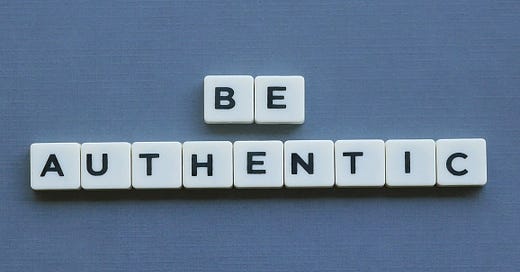Authenticity. What do you think when you hear it? Curiosity? A smile of recognition? An inner eye roll of “not that again”?
If it was the last option I wouldn’t blame you. The word has become ubiquitous, a sort of shorthand for good leadership. I think it has become overused, and arguably so varied in its interpretation that its usefulness has probably declined.
I don’t want to throw the concept away entirely, and in a very crowded field, I certainly won’t claim to offer the definitive meaning! But I think it’s helpful to look at a few misconceptions around authenticity in leadership, and I will share the way I like to think about it.
Here’s a few things I think it isn’t….
It doesn’t mean “show up and throw up”!
Showing up as your whole self isn’t a helpful way to think about it, as we all have sides of us that - quite rightly - don’t need to be brought out in public. Equally, it isn’t helpful to show every single emotion that we feel throughout a working day, especially if you’re in a position of authority. That’s not to say leave emotions at the door. As humans, we are inherently emotional creatures and we don’t need to feel shame for that, but we can and do need to manage their impact on others in a professional setting.
It also doesn’t mean saying everything that comes into your head or being bluntly honest in every interaction. It is not an excuse to be tactless, disrespectful or mean, and it certainly isn’t about putting yourself first at the cost of everyone else.
It isn’t a fixed way of being
Being authentic is dynamic and contextual, and will look different over time and in different situations and environments. Relating to it as a particular way to be and behave can trap you into looking for the “right” way to be a leader, which ironically, is one of the things I think the term sought to move leadership away from in the first place.
It isn’t the right way to lead
It is one lens to look at leadership, helpful for some, not for others. There is no strong evidence that it is any better than many other approaches. Political skills, emotional intelligence, personality, self-awareness and regulation, impulse control and many other elements have been shown to be common amongst high-performing leaders and don’t neatly fit under the umbrella of authenticity.
It doesn’t automatically create diversity
As a white, middle-class, cis-gendered, heterosexual, financially secure woman I have a lot of freedom to speak my mind and act as I choose, with little fear of the consequences. That is very definitely not true for many people. It is a noble goal to seek to create an environment where everyone feels safe to be themselves and can bring their best thinking, but it is crucial to remember that will feel much harder and much less safe to some based on their lived experiences and systemic bias. And until that psychologically safe environment exists, asking people to be authentic is almost meaningless.
So how can it be useful?
I think it’s useful to challenge your thinking, help you take a look at yourself and your leadership.
Where do I feel I have to fit in rather than being myself? What if I allowed myself to be more “me”? What would that take?
What are my values? What is important to me? How aligned is what I do and where I work with those? If they are misaligned, what do I want to do with that?
Where am I unwilling to be vulnerable? How might sharing a little more of me, what I’m thinking and how I’m feeling, help those around me?
These can also be conversation starters with your team, both for them to think for themselves, and to see how you can support them to get the best out of them. I think it is the inquiry and the conversations around authentic leadership that offers value, rather than the pursuit of it as a destination at any cost!
Sweating the Small Stuff
As I near the end of writing Do Sweat the Small Stuff (out July 2024) I’m going to start to include one idea each week looking at how to practise this, related to the topic of the newsletter.
This week: Cut out the jargon
Authentic leadership is a great example of the problem with jargon. The meaning is confused, so we think we are using a term that is shorthand for something, but in fact it is confusing our message.
Where do you use jargon? How much do you rely on it? Try cutting it out for a while to see the difference. It will usually make you think more about what you are actually trying to say, and through that, you will communicate more clearly and more inclusively.
What are you thoughts? Join the conversation by leaving a comment below.
If you’ve enjoyed this, hit subscribe to receive my future posts direct to your inbox.
Or, please do share with friends, colleagues or anyone you think would enjoy this using the button below.



